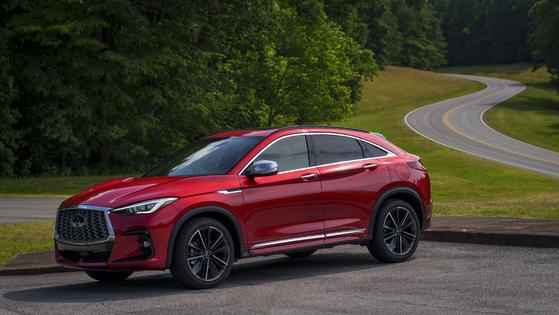Eric's Autos: 2025 Infiniti QX55
Mercedes and BMW were the first to come up with what they called the four-door coupe -- or words to that effect. The idea was to take something boxy and practical and make it look more like a coupe while still being practical. The Mercedes GLA, for instance, is a Mercedes GLB SUV -- with a lower/swept-back roofline, to give it a "coupe-like" silhouette.
Of course, good looks tend to cost more and be less practical, and Infiniti's QX55 is no different in both respects.
What It Is
The QX55 is a more stylish, more expensive and less practical version of the Infiniti QX50, which is a compact crossover with two rows and seating for five. Both are offered by Nissan's luxury division, Infiniti.
Both come standard with the same drivetrain and many of the same features and amenities, but the base price of the more stylish QX55 -- $50,150 for the Lux trim -- is about $7,100 higher than the base price of the basically-the-same-thing QX50, which lists for $43,000 to start.
The base Lux trim comes standard with 20-inch wheels, LED headlights, leather sets and a sunroof. All-wheel drive is also standard.
Moving up to the Essential trim -- $55,100 -- adds seat heaters and a heated steering wheel, adaptive headlights that track with the steering wheel as it is turned, and a 16-speaker Bose premium audio system.
A top-of-the-line Sensory trim -- $58,650 -- adds upgraded leather upholstery, a heads-up display for the driver, three-zone climate control and heaters for the rear outboard seats.
What's New for 2025
The QX55 carries over unchanged. Even the price remains the same, which means Infiniti has lowered the price (effectively) given the ongoing devaluation of the dollar; i.e., "inflation."
What's Good
-- More stylish looking than the QX50.
-- Still practical in that it's still a crossover with four doors and much more space for cargo due to the crossover layout.
-- Larger than a Mercedes GLA -- and vastly less expensive than a Mercedes GLE "coupe."
What's Not So Good
-- Costs about $7,000 more to start than a Mercedes GLA.
-- No available engine upgrade.
-- Continuously variable transmission.
Under the Hood
Every QX55 (and every QX50) comes standard with the same drivetrain. It consists of a turbocharged 2.0-liter four-cylinder engine that touts 268 horsepower and 280 foot-pounds of torque that's paired up with a CVT and standard AWD.
The QX55's 2.0-liter four uses a variable compression system to increase or decrease the compression ratio to improve power and efficiency. This is achieved via connecting rods that can pivot in relation to the engine's crankshaft. Nissan/Infiniti is the only vehicle manufacturer currently selling variable compression engines.
Another difference that is also unusual in the luxury crossover segment is that the QX55's 2.0-liter four is not paired up with a hybrid system. Infiniti has been a latecomer to hybridizing its drivetrains. But it was one of the first to deploy the CVT as a compliance measure.
CVTs originally appeared in economy-minded cars (Honda was among the first to offer them) because the gearless/shiftless CVT offers a fuel economy benefit versus a conventional automatic that has gears and shifts. The CVT works by continuously varying the mechanical relationship between the engine and the drive wheels to optimize economy. The idea is to basically keep the engine operating at just exactly the right RPM for every given road speed and load, so as to maximize the engine's efficiency. A conventional automatic's forward gears are for obvious reasons not as fluid. You're in second or third or fourth -- not somewhere in between, which is what a CVT can do and why a given vehicle equipped with a CVT will typically score about 3 mpg higher on government fuel economy tests than the same vehicle with an automatic.
The problem with the CVT -- in a luxury-brand vehicle -- is that its shift-free operating characteristics are often not in sync with the way most luxury car buyers expect a luxury vehicle to feel (and sound).
On the Road
The QX55 takes about 6.4 seconds to get to 60 mph. This isn't quite as quick as rival small crossovers from Mercedes and BMW but it's not slow. The difference of 0.2 or 0.3 seconds is one that is generally noticeably only by the stopwatch.
What is noticeable is the way the CVT feels -- and sounds. CVTs feel and sound like economy car transmissions because that's what they were designed to be. The feel is rubber bandy, almost like the thing is slipping when you're accelerating. In fact, what it's doing is easing from one range to the next, continuously. But this feels vague and sounds worse. The engine's RPM rises and holds, then kind of slips lower or higher depending on how much downward pressure the driver is applying to the accelerator pedal. It sounds and feels OK once you've reached cruising speed; it's the in-betweens that aren't optimal. A CVT in a Honda is one thing.
A CVT in an Infiniti is something else.
On the upside, the QX55 does not come with a massive driver-distracting LCD display, and it is one of the few new luxury-brand crossovers that does not have a "digital" dashboard, either. Instead, there's a pod of analog-style gauges, which have become a kind of luxury now that pretty much everything comes standard with cheap-looking smartphone-style displays.
Otherwise, there's nothing much different here. That is not to say the QX55 isn't pleasant or comfortable to be in. The problem is that they all are; more finely, that even non-luxury-brand vehicles are as pleasant and comfortable to be in as the luxury-brand ones.
The big difference nowadays is what they each cost.
At the Curb
The QX55 is 186.3 inches long, which is just shy of 2 inches less long than the QX50 it's based on. But the main difference is the roofline of the QX55. And the height of the QX55 versus that of the QX50.
The QX55 stands 63.8 inches at the roofline; the QX50 stands more than 2 inches higher (66 inches). That's the difference that makes the QX55 look less like a crossover and more like something sportier. Of course, sportier usually entails functional compromises and that's the case here too.
Headroom in both of the QX55's two rows is noticeably less than it is in the QX50, which has 41 inches of headroom up front and almost as much headroom (39.1 inches) for those in the second row. The QX55 has 39.9 inches up front and only 36.9 inches in the rear. Backseat passengers 6 feet tall or more may find they have to duck in order to avoid their heads rubbing up against the headliner in the back of the QX55.
There is also, predictably, a loss of cargo volume. The QX50 has 31.4 cubic feet of space for stuff behind its second row and 65.1 cubic feet of available cargo capacity with the second-row seatbacks folded. In the QX55, this drops to 26.9 cubic feet of cargo capacity behind the second row and 54.1 cubic feet of total capacity.
The Rest
The word is that this will be the final year for the QX55, so if you're interested in one, it is probably a great time to shop for one, as dealers are more likely to be willing to deal on a model that's on the way out.
The Bottom Line
Stylishness almost always comes with a price, functionally as well as financially. How much is looking different worth to you?
========
Eric's latest book, "Doomed: Good Cars Gone Wrong!" will be available soon. To find out more about Eric and read his past columns, please visit the Creators Syndicate webpage at www.creators.com.
Copyright 2025 Creators Syndicate, Inc.








Comments